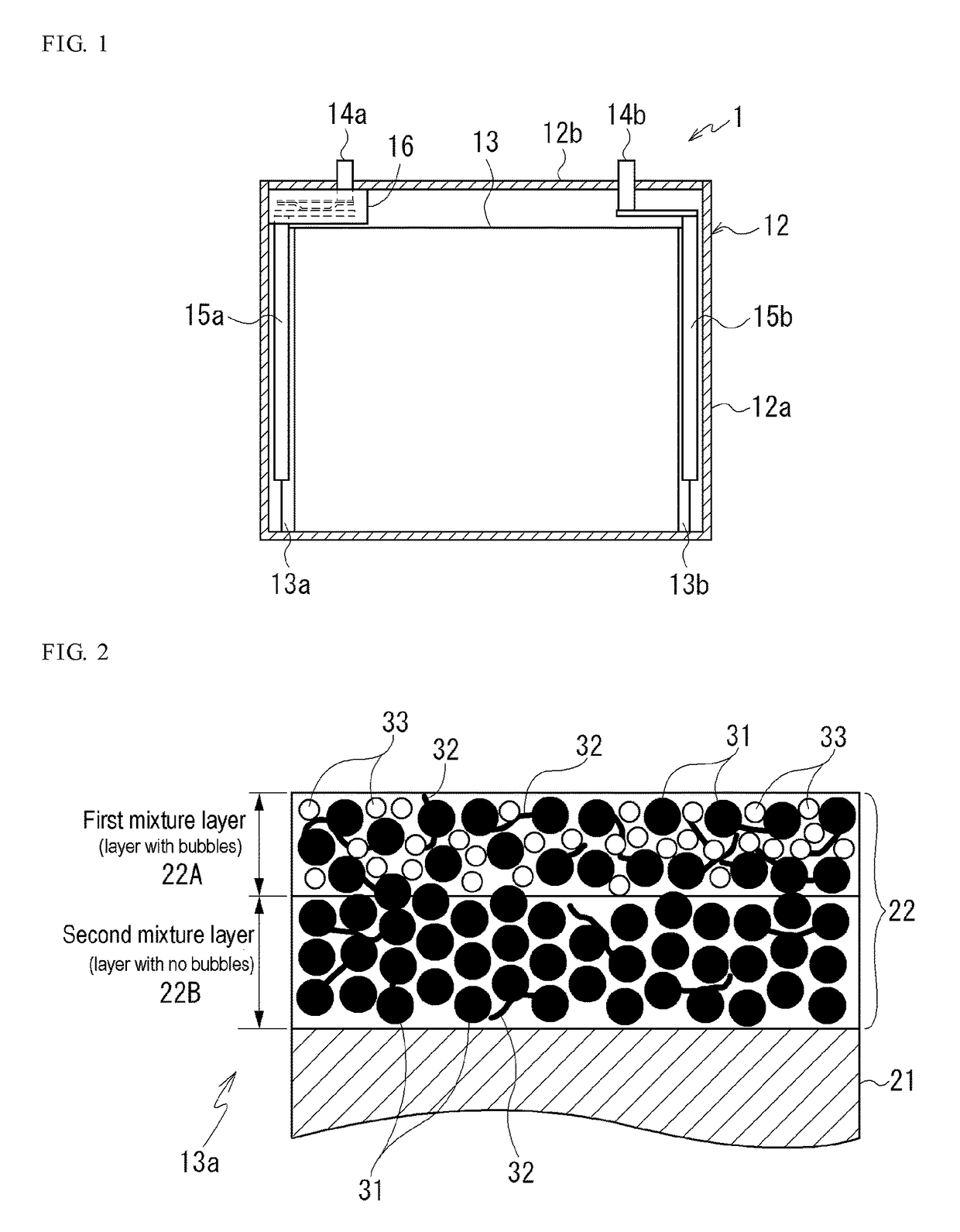Positive electrode for nonaqueous electrolyte secondary batteries, and nonaqueous electrolyte secondary battery
a technology of electrolyte secondary batteries and positive electrodes, which is applied in the direction of electrochemical generators, cell components, cell component details, etc., can solve the problems of deterioration of high-rate characteristics, many voids not only on the surface, and insufficient electric conductivity between particles, etc., to achieve efficient gas generation and efficient gas release
- Summary
- Abstract
- Description
- Claims
- Application Information
AI Technical Summary
Benefits of technology
Problems solved by technology
Method used
Image
Examples
example 1
[0051]A second positive electrode mixture paste for forming the second mixture layer 22B was prepared by using a positive electrode active material having an average particle diameter d50 of 5.7 μm and comprising a “lithium composite oxide (Li(Ni, Mn, Co)O2)” as a positive electrode active material, “acetylene black (AB)” as a conductive material, and “polyvinylidene fluoride (PVdF)” as a binding material; mixing the positive electrode active material, the conductive material and the binding material in a ratio (weight ratio) of 100:5:2; and kneading the mixture using “N-methyl-2-pyrrolidone (NMP)” as a solvent.
[0052]A first positive electrode mixture paste for forming the first mixture layer 22A was prepared by preparing a positive electrode mixture paste similar to the second positive electrode mixture paste except that a positive electrode active material having an average particle diameter d50 of 3.0 μm and comprising a “lithium composite oxide (Li(Ni, Mn, Co)O2)” was used as a ...
example 2
[0063]The positive electrode 13a of Example 2 was prepared in the same manner as in Example 1 except that the second positive electrode mixture paste of Example 1 was applied onto each of both surfaces of a 15 μm-thick aluminum foil as the current collector 21 in an amount of 13 mg / cm2, and the first positive electrode mixture paste of Example 1 was then applied in an amount of 2 mg / cm2 onto the second positive electrode mixture paste applied onto each of both surfaces of the aluminum foil. The nonaqueous electrolyte secondary battery 1 of Example 2 was formed in the same manner as in Example 1 except that the positive electrode 13a of Example 2 was used.
[0064]The ratio (A / B) of the thickness A of the first mixture layer 22A to the thickness B of the second mixture layer 22B in the positive electrode mixture layer 22 of the positive electrode 13a of Example 2 is 0.15.
[0065]When a pore size distribution in the positive electrode mixture layer 22 of the positive electrode 13a of Examp...
example 3
[0066]The positive electrode 13a of Example 3 was prepared in the same manner as in Example 1 except that the second positive electrode mixture paste of Example 1 was applied onto each of both surfaces of a 15 μm-thick aluminum foil as the current collector 21 in an amount of 8 mg / cm2, and the first positive electrode mixture paste of Example 1 was then applied in an amount of 7 mg / cm2 onto the second positive electrode mixture paste applied onto each of both surfaces of the aluminum foil. The nonaqueous electrolyte secondary battery 1 of Example 3 was formed in the same manner as in Example 1 except that the positive electrode 13a of Example 3 was used.
[0067]The ratio (A / B) of the thickness A of the first mixture layer 22A to the thickness B of the second mixture layer 22B in the positive electrode mixture layer 22 of the positive electrode 13a of Example 3 is 0.88.
[0068]When a pore size distribution in the positive electrode mixture layer 22 of the positive electrode 13a of Exampl...
PUM
| Property | Measurement | Unit |
|---|---|---|
| particle diameter | aaaaa | aaaaa |
| particle diameter | aaaaa | aaaaa |
| diameter | aaaaa | aaaaa |
Abstract
Description
Claims
Application Information
 Login to View More
Login to View More - R&D
- Intellectual Property
- Life Sciences
- Materials
- Tech Scout
- Unparalleled Data Quality
- Higher Quality Content
- 60% Fewer Hallucinations
Browse by: Latest US Patents, China's latest patents, Technical Efficacy Thesaurus, Application Domain, Technology Topic, Popular Technical Reports.
© 2025 PatSnap. All rights reserved.Legal|Privacy policy|Modern Slavery Act Transparency Statement|Sitemap|About US| Contact US: help@patsnap.com



